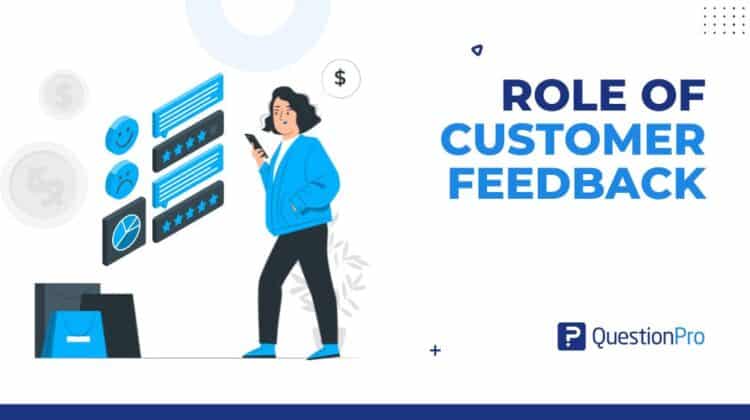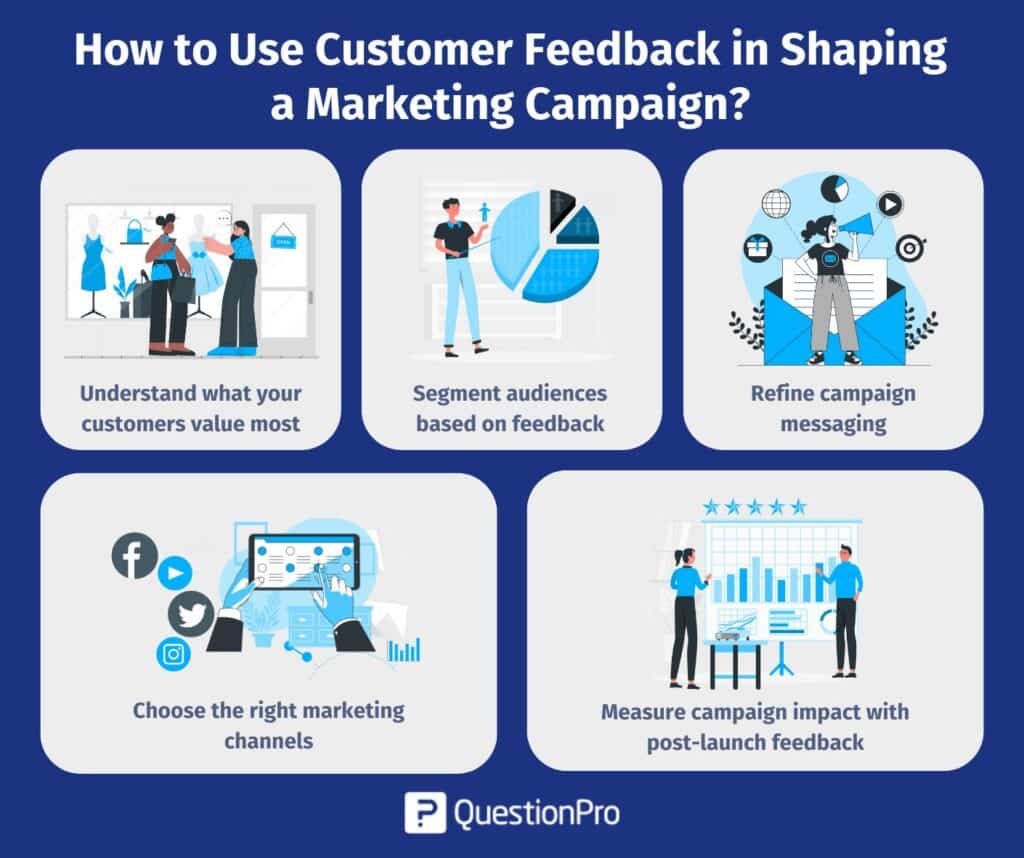
If you want your marketing to actually connect with your audience, you need to listen to them. Understanding the role of customer feedback can help you shape your marketing strategy. Without that feedback, you are guessing. With it, you have a guide that can help you adjust your message, improve your campaigns, and build real connections with your customers.
When you actively collect and review customer feedback, you can shape your marketing around their needs, identify what is not working early, and stay closer to their expectations.
In this blog, we’ll explore the key role of customer feedback and how it shapes successful marketing campaigns.
What are the key roles of customer feedback?
Customer feedback acts like a mirror. It reflects how well your products, services, and overall experience meet customer needs. When you understand the role of customer feedback, you can clearly see your strong points and the gaps that need attention.
Here are some major roles of customer feedback:
1. Improves products and services
The main role of customer feedback is to help companies identify what’s working and what needs improvement. When customers share their thoughts through surveys or reviews, they highlight issues that might go unnoticed internally.
Businesses can use this information to:
- Fix recurring product or service problems
- Enhance usability and overall performance
- Prioritize updates based on real user needs
- By turning these insights into action, companies build products that better match customer expectations.
2. Builds customer trust and loyalty
Listening to customers isn’t just about collecting opinions. It’s about showing that their voices matter. When businesses acknowledge and act on feedback, they build emotional connections that lead to loyalty.
A simple “thank you” or a visible improvement based on customer suggestions reinforces trust and makes customers feel valued. Over time, this kind of engagement creates lasting relationships and positive word-of-mouth.
3. Guides business decisions
Another important role of customer feedback is helping organizations make smarter, data-based decisions. Instead of guessing what customers want, feedback provides clear insights that guide:
- Product development priorities.
- Marketing strategies and campaign messages
- Service enhancements or new offerings
This actual input ensures that every decision aligns with customer needs, not internal assumptions.
4. Measures customer satisfaction
Customer feedback is a direct signal of how happy customers are with your company.
Tools like customer satisfaction score (CSAT), net promoter scores (NPS), and star ratings help measure how well products and services are performing.
When teams review these metrics regularly, they can quickly spot negative trends, fix problems, and maintain a consistent level of satisfaction.
5. Inspires innovation and growth
Some of the best ideas come from the people who use your products every day.
Through ongoing feedback loops, customers reveal pain points and new opportunities that can inspire innovation.
For example, analyzing comments from usability testing or support tickets might uncover fresh ideas for features or improvements. By listening closely, businesses can adapt more quickly, stay relevant, and continue growing with confidence.
How to use customer feedback in shaping a marketing campaign?
The role of customer feedback in marketing is simple. It helps you understand what your audience actually cares about. Instead of guessing what message or design will work, feedback gives you clear signals straight from your customers. By analyzing their opinions, preferences, and pain points, marketers can build campaigns that connect on a personal level and perform better across every channel.
Here’s how you can use customer feedback to shape a marketing campaign effectively:

1. Understand what your customers value most
Before creating a campaign, it’s essential to know what matters to your audience.
Customer feedback highlights their motivations, expectations, and concerns.
For example:
- What do they love about your product?
- What problems are they trying to solve?
- What language or tone do they respond to best?
By reviewing survey responses, online reviews, and social media comments, you gain real customer insights that help tailor your campaign message to their true needs.
2. Segment audiences based on feedback
Not every customer wants the same thing. Feedback allows marketers to group customers based on preferences, habits, or satisfaction levels.
For example:
- Promoters (happy customers) can be targeted with referral campaigns.
- Detractors (unhappy customers) can receive personalized offers or support outreach.
This customer feedback analysis helps create focused campaigns that speak to the right people at the right time, improving both engagement and conversion rates.
3. Refine campaign messaging
One of the most practical ways of using customer feedback in business strategy is to test and adjust messaging before a full campaign launch.
If customers repeatedly mention certain benefits or frustrations, include those points in your ad copy or visuals.
For example, if reviews often say your service “saves time,” that phrase can become a headline in your campaign. This approach ensures your message reflects consumer perception rather than assumptions from within the company.
4. Choose the right marketing channels
Feedback can also reveal where your customers prefer to interact. By analyzing responses and social data, you might learn that:
- Younger audiences engage more on Instagram.
- Professionals prefer LinkedIn or email newsletters.
- Long-time customers respond better to personalized SMS messages.
Understanding these patterns helps allocate your marketing budget more effectively and reach your audience through the channels they actually use.
5. Measure campaign impact with post-launch feedback
Once the campaign is live, continue collecting feedback. This step closes the feedback loop and helps evaluate what worked and what didn’t.
Use quick polls or follow-up surveys to measure customer satisfaction and identify areas for improvement.
This ongoing feedback process ensures your marketing stays aligned with audience expectations and continuously improves over time.
How feedback loops improve campaign optimization
A feedback loop is the process of taking data or responses from your audience, such as clicks, likes, sales, or comments, and analyzing them to see how your campaign performed. You then use those insights to adjust your strategy and try again. Over time, this cycle of testing, learning, and improving makes your campaigns stronger and more effective.
Why it matters in campaign optimization
Without feedback, you would be guessing what your audience wants. But with feedback, you get real information that guides your choices. For example, if an ad gets a lot of clicks but few purchases, the feedback tells you something is off. Maybe the message is interesting, but the offer or landing page needs work.
By paying attention to these signals, marketers can tweak their content, target the right audience, and spend their budget more wisely.
How the process works
Here’s how a typical feedback loop might look in campaign optimization:
- Launch the campaign: You create and share your ad or content.
- Collect data: You track how people respond (clicks, sign-ups, conversions, etc.).
- Analyze results: You look for patterns, like which ads perform best or what time of day brings the most engagement.
- Make improvements: Based on what you learned, you make adjustments and run the campaign again.
- Close the Loop: Once improvements are made, communicate with your audience, showing them you’ve listened to their feedback and taken action.
This ongoing cycle helps you fine-tune your strategy and get better results each time.
Benefits of feedback loops
Better understanding of your audience: You learn what truly connects with people.
- Smarter decisions: Data-driven choices replace guesswork.
- Higher ROI: As campaigns become more efficient, you get more value for your money.
- Continuous improvement: Each round makes your marketing stronger than before.
Example of a feedback loop in optimizing a marketing campaign
Imagine you run a restaurant and launch a marketing campaign to promote a new seasonal menu. You create an eye-catching ad and share it through social media and email newsletters. After the campaign goes live, you track customer responses and send out a post-visit survey. Feedback reveals that while customers love the dishes, many feel the portions are too small for the price.
Based on this, you adjust the portion sizes and lower the price to offer better value. You update the campaign materials to reflect these changes and send a follow-up email to customers, thanking them for their feedback and offering a discount on their next visit.
This feedback loop allows you to continuously improve your marketing campaign, strengthen customer relationships, and ensure that future campaigns better meet your audience’s needs.
How to build an effective feedback loop with QuestionPro?
Building an effective feedback loop is essential for improving your business and keeping your customers happy. A feedback loop means collecting customer opinions, acting on them, and then gathering more feedback to see how well the changes worked. QuestionPro makes this process easy with all the tools you need to gather, analyze, and take action on customer feedback, helping you create a continuous cycle of improvement.
Here’s how you can build an effective feedback loop using QuestionPro:
1. Collect feedback efficiently
The first step in creating a feedback loop is gathering the right feedback. QuestionPro makes it easy to create surveys tailored to your needs, whether you’re asking for customer satisfaction, product feedback, or event insights.
You can:
- Use ready-made templates for quick surveys.
- Choose from multiple question types like multiple choice, Likert scales, and open-ended questions.
- Send surveys via email, website pop-ups, or social media so you can reach customers wherever they are.
2. Analyze feedback with real-time reports
Once you start collecting feedback, you need to make sense of it. QuestionPro’s real-time analytics and customizable dashboards give you quick insights into customer satisfaction and common issues.
You can view:
- Trends in customer satisfaction over time.
- Common feedback themes like product complaints or service praise.
- Key metrics like NPS (Net Promoter Score) or CSAT (Customer Satisfaction).
This helps you quickly identify areas for improvement and decide what changes to make.
3. Act on the feedback
The key to an effective feedback loop is turning the insights into action. QuestionPro helps you take the next steps by allowing you to:
- Identify patterns in the feedback to spot common pain points or opportunities.
- Prioritize changes based on customer needs, such as improving a feature customers frequently mention or fixing a customer service issue.
4. Communicate changes back to customers
Once you’ve made improvements, it’s important to let your customers know. QuestionPro allows you to send follow-up surveys or emails to thank customers for their feedback and let them know about the changes you’ve made.
This step closes the feedback loop by showing customers that their input is valued and leads to real change. It also builds trust and encourages customers to keep providing feedback.
5. Continue the cycle
Feedback loops are ongoing. With QuestionPro, you can schedule recurring surveys or set up automated feedback triggers so that you keep collecting insights over time.
For example, you could send a follow-up survey three months after a product launch to see how customers feel about it now, or you can automate feedback requests after key customer interactions.
This continuous feedback collection ensures that your campaigns, products, or services are always improving.
Conclusion
Customer feedback is the foundation of successful marketing campaigns. It gives you the clarity to understand your audience, refine your strategies, and optimize your efforts. By actively listening to your customers, you unlock valuable insights that help you improve your messaging, build stronger relationships, and make data-driven decisions that truly resonate with your target audience.
From using feedback to enhance products and services to shaping targeted marketing campaigns and optimizing performance through feedback loops, every step of the process is driven by what your customers are telling you. Tools like QuestionPro simplify this journey by offering easy-to-use platforms for collecting, analyzing, and acting on feedback in real-time.
Frequently Asked Questions (FAQs)
Answer: Customer feedback helps businesses understand their audience’s needs, preferences, and pain points. It ensures marketing campaigns are aligned with what customers truly want, leading to more effective messaging and stronger engagement.
Answer: You can collect customer feedback using surveys, online reviews, social media, or customer interviews. Tools like QuestionPro make it easy to create surveys, analyze responses, and track customer sentiment.
Answer: A feedback loop in marketing involves collecting customer feedback, analyzing it, making adjustments to your campaigns, and then testing again. It helps optimize marketing strategies over time by continuously improving based on customer insights.
Answer: Using customer feedback helps businesses improve customer satisfaction, increase loyalty, refine product offerings, and make data-driven decisions. It ensures that marketing strategies are always relevant and effective.
Answer: It’s essential to gather feedback regularly. This can be through post-purchase surveys, quarterly reviews, or after major marketing campaigns. Regular feedback helps ensure your marketing strategies stay up-to-date and effective.







